Hyperparathyroidism and Vitamin D
Vitamin D’s main function in the body is to help the intestines absorb calcium, but it does a lot more. Vitamin D, calcium levels and parathyroid gland function are intimately involved. To understand this relationship better we have to first discuss how the body creates and activates vitamin D. There are 2 ways the body makes the chemical that ultimately becomes Vitamin D: (1) either by using sunlight (UVB) to transform cholesterol to inactive Vitamin D (cholecalciferol) or (2) or by us ingesting Vitamin D2 or Vitamin D3 in our diet. Both processes are usually working at the same time for each of us.
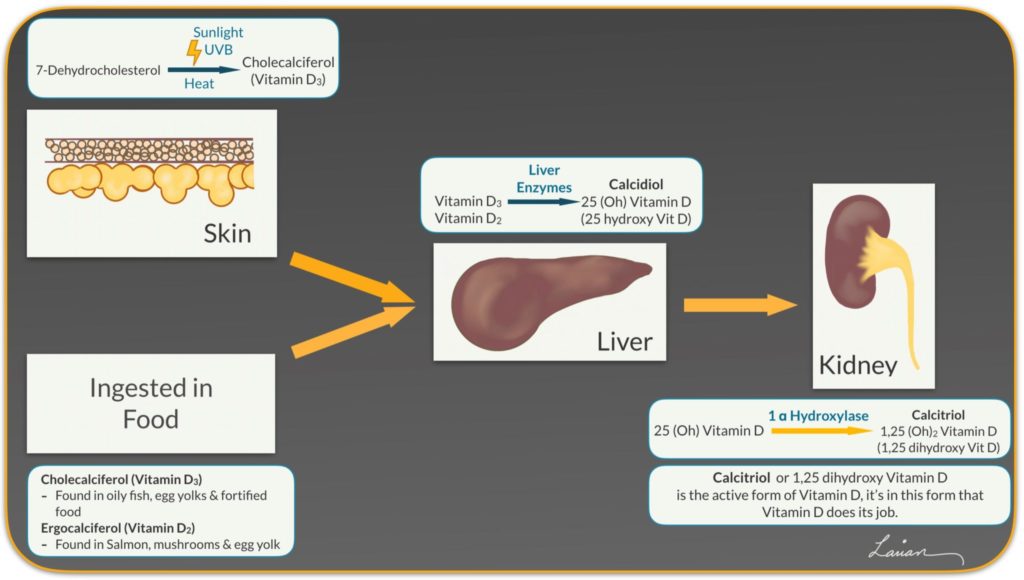
These forms of Vitamin D then go through the liver where they are transformed into Calcidiol or 25 hydroxy Vitamin D. After coming out of the liver this form of inactive Vitamin D travels through the blood to reach the kidney. In the kidney, PTH stimulates activation of Vitamin D3 into Calcitriol or 1,25 dihydroxy Vitamin D3.
Activated Vitamin D3 goes into bloodstream and throughout the body. In terms of its effect on the calcium balance, it has the most impact on absorption of calcium in the small intestines. It also caused the kidney to absorb more calcium from the urine, the parathyroid gland to make less PTH, and the bones to release calcium & phosphorus in small amounts while at the same time helping to mature the cells that make & reshape bone to make it stronger.
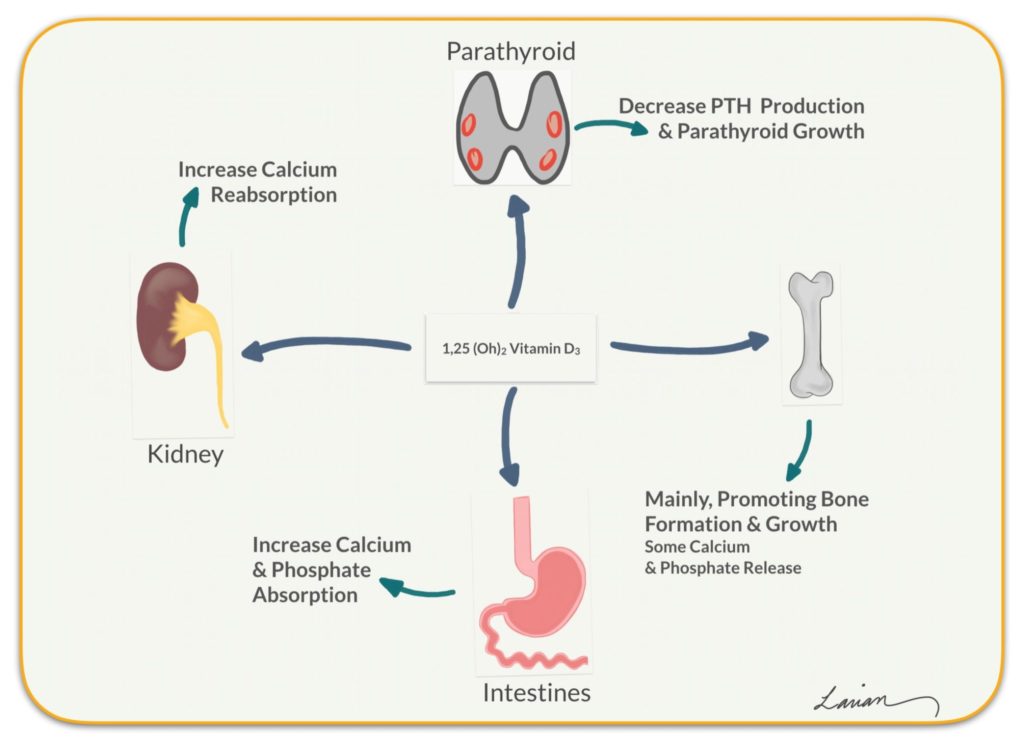
On a cellular level, Vitamin D enters the parathyroid cell and stops the manufacturing of PTH and also promotes the production of a protein called p21. The p21protein stops the parathyroid from duplicating and essentially gets in the way of the parathyroid gland growing.
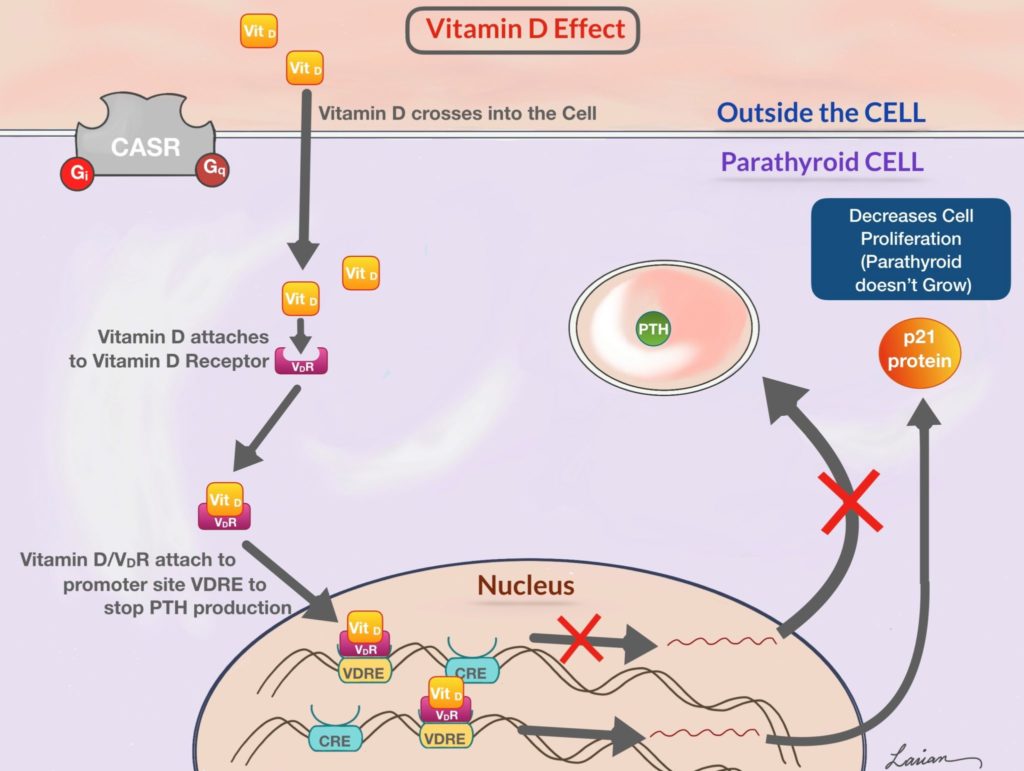
Other Benefits of Vitamin D
Vitamin D seem to be involved in many processes in the body. The following is a list of potential benefits of vitamin D; I say potential because not all of these have been clearly shown.
- Boosting immunity
- Reduction of cardiovascular risk
- Supporting a healthy pregnancy
- Reducing the risk of Alzheimer’s disease
- Protection against diabetes
- Reducing inflammation
- Combating depression
- Reducing the chance of cancer
Vitamin D Deficiency: Here’s What You Need to Know
A vitamin D deficiency refers to a condition in which an individual doesn’t have sufficient vitamin D in the body. When vitamin D level is low, the absorption of calcium in the intestines becomes less, which then causes the level of calcium in the blood to go down. As a consequence the parathyroid glands become more active and produce more PTH that causes calcium to come out of the bones, therefore weakening the bones. An individual with vitamin D deficiency may experience a wide range of health problems if the issue goes unaddressed for an extended period of time.
There are many reasons why an individual may become vitamin D-deficient, including:
- Lack of vitamin D-rich foods in his or her diet
- Malabsorption issues that make it difficult for the body to absorb vitamin D from food
- Limited sun exposure
- Liver or kidneys that struggle to convert vitamin D to its active form in the body
- Use of medicines that disrupt the body’s ability to convert or absorb vitamin D
Some individuals are more prone to vitamin D deficiencies than others, such as:
- Older Adults: As a person ages, his or her skin becomes less effective in absorbing vitamin D from sunlight.
- People with Dark Skin: Darker skin is an adaptation to protect against the harmful effects of too much sun exposure, which also means there is less UVB light available to make vitamin D. Typically people with darker skin need more sun exposure to make vitamin D in comparison to individuals with lighter skin. In the modern era of indoor living & work we are all exposed to less sunlight.
- People Dealing with Obesity: Vitamin D is a fat soluble, which means it easily goes into fat cells. Excess body fat sometimes binds to vitamin D and prevents it from reaching the blood.
The American Academy of Pediatrics recommends children and infants receive at least 400 IU of vitamin D daily from diet and supplements. Meanwhile, research shows that adults who consume 700 to 800 IU of vitamin D daily are less prone to bone fractures
How to Diagnose a Vitamin D Deficiency
A 25 hydroxy vitamin D blood test isis the primary way to diagnose vitamin D deficiency. During this test, a doctor measures how much vitamin D is present in a person’s body. If an individual’s vitamin D level is less than 20 ng/mL, then he or she will be diagnosed as vitamin D-deficient based on the guidelines of American Institute of Medicine. The experts at Endocrine Society consider levels lower than 30 ng/mL as vitamin D deficiency. If an individual discovers that he or she is vitamin D-deficient, there is no need to stress. A doctor will work with the patient to identify the root cause of vitamin D deficiency and develop a personalized treatment plan.
How to Treat a Vitamin D Deficiency
Dietary changes and the use of supplements often help people overcome vitamin D deficiencies.
Many foods naturally contain high levels of vitamin D, and these foods include:
- Beef liver
- Oily fish (Salmon, Tuna, Sardines & Mackerel)
- Fish Oil
- Cheese
- Egg yolks
- Mushrooms (Shiitake)
Various fortified foods also contain high levels of vitamin D, and these foods include:
- Milk
- Cereal
- Orange juice
- Yogurt and other dairy products
Vitamin D supplements are available in both pill and liquid forms. They can be taken regularly to help an individual address a vitamin D deficiency.
For vitamin D-deficient individuals who are considering dietary changes or the use of supplements, it is essential to meet with a doctor in advance. This ensures that an individual can work with a doctor to determine a safe, effective way to treat his or her vitamin D deficiency.
Vitamin K2
Vitamin D & Vitamin K2 are complimentary vitamins. While Vitamin D is necessary for absorbing calcium from food in the intestines, Vitamin K2 does two functions that help direct the calcium to the correct spot:
- by activating Osteocalcin, a protein that promotes accumulation of calcium in bones and teeth, and
- by decreasing accumulation of calcium in soft tissues, such as kidneys and blood vessels
Vitamin K2 is found in beef liver, egg yolk, soft cheese and fermented foods.
Is It Possible to Consume Too Much Vitamin D?
Because Vitamin D can go into fat cells, we can hold extra vitamin D in our body, which can build up over time. Vitamin D is one of 4 vitamins that can be accumulated in the body to toxic levels. Other vitamins when there is extra are disposed of in the urine (part of the reason urine changes colors with extra vitamin use), unfortunately that doesn’t happen with vitamin D. Excess consumption of vitamin D is problematic, the levels can become toxic, and it may cause any of the following symptoms:
- Nausea
- Vomiting
- Constipation
- Lack of appetite
- Weakness
- Weight loss
High levels of vitamin D may also raise a person’s calcium level. In this instance, an individual may experience confusion, disorientation, and heart rhythm issues.
Why Does Vitamin D Deficiency Cause Secondary Hyperparathyroidism?
If vitamin D deficiency is present in a person for a long time, the PTH level can increase causing bones to release more calcium into the bloodstream and may be accompanied by mild elevation in calcium, or it may not. This, in time, can cause symptoms of hyperparathyroidism to occur, and also loss and weakening of the bone. This is considered to be a state of secondary hyperparathyroidism; secondary due to vitamin D deficiency. Generally, this condition can be easily corrected by replacing vitamin D, which will lead to PTH levels coming back to normal
What Is the Link Between Primary Hyperparathyroidism and Vitamin D Deficiency?
Vitamin D deficiency is common in modern society, but it is significantly more common in people who have primary hyperparathyroidism. PHPT with vitamin D deficiency is usually present in the more severe forms of PHPT and comes with a higher rate of bone loss or osteoporosis. The reason for vitamin D deficiency being so common is not clear, some have believed it is because the higher PTH level causes more transformation of 25 OH Vitamin D to 1,25 OH Vitamin D. Most likely there are other processes occurring in the body that diminish Vitamin D levels as a means of protecting the body against higher calcium levels. The reason is unclear, however vitamin D deficiency does cause a lot of problems and needs to be treated appropriately.
Studies have also shown that large adenomas, high PTH levels, and more severe bone disease are more common in PHPT patients dealing with a vitamin D deficiency in comparison to all other vitamin D-deficient individuals. In the absence of vitamin D, the parathyroid gland is not suppressed and can grow larger, PTH production is not inhibited so the level is higher (giving more symptoms), and bones are less protected leading to more bone loss.
The combination of PHPT and vitamin D deficiency has effects on other systems as well including the pancreas and Insulin, blood vessels, and kidneys leading to many other complications.
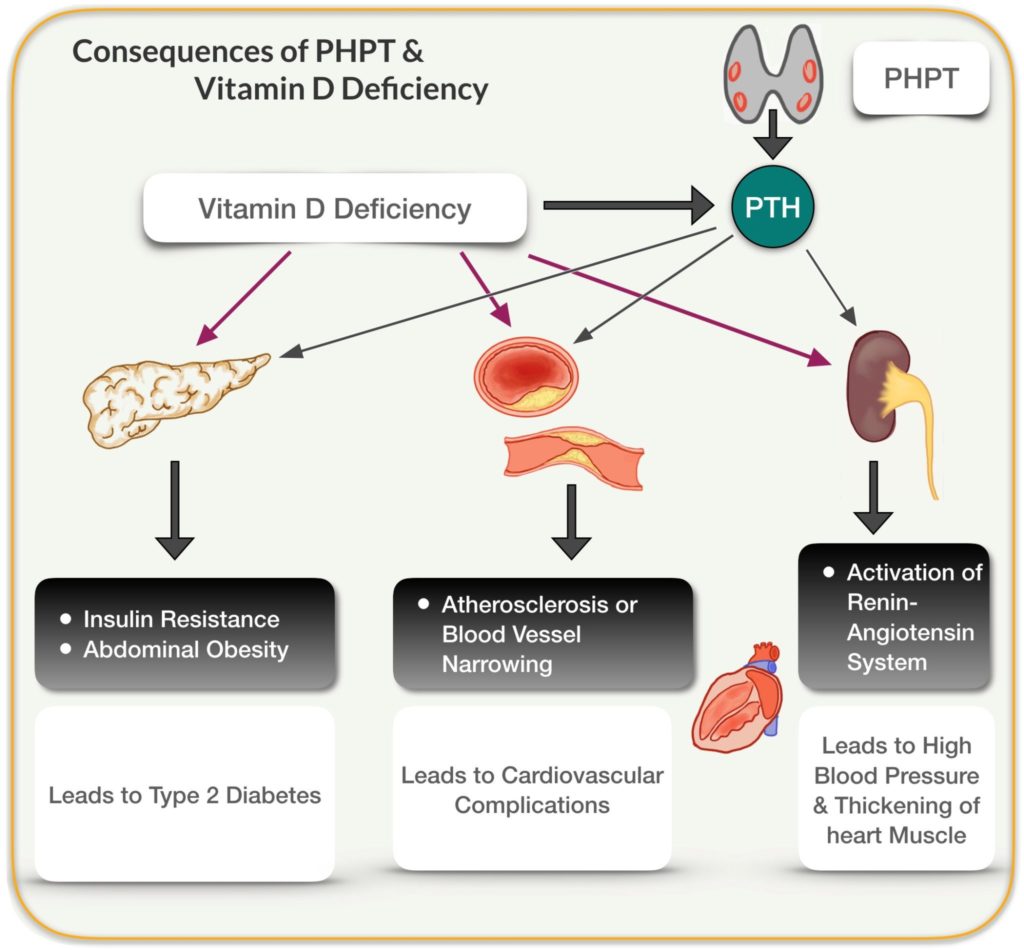
Although some still feel vitamin D replacement is dangerous and can cause problems, research clearly indicates that when vitamin D is replaced in a controlled fashion with the help of a doctor and lab testing, it can be very safe. Additionally, replacing vitamin D does not cause elevation in calcium in the blood or urine, while at the same time bring down the PTH level.
How to Treat Vitamin D Deficiency and Hyperparathyroidism
In great number of cases one may find on blood tests that 25 hydroxy vitamin D (25 OH Vit D) levels are low, but 1,25 dihydroxyvitamin D 1,25 OH Vit D) is normal or elevated. This occurs because PTH is actively transforming 25 OH Vit D to 1,25 OH Vit D.
Vitamin D replacement in the setting of PHPT has been shown to have positive impact when monitored by your physician.
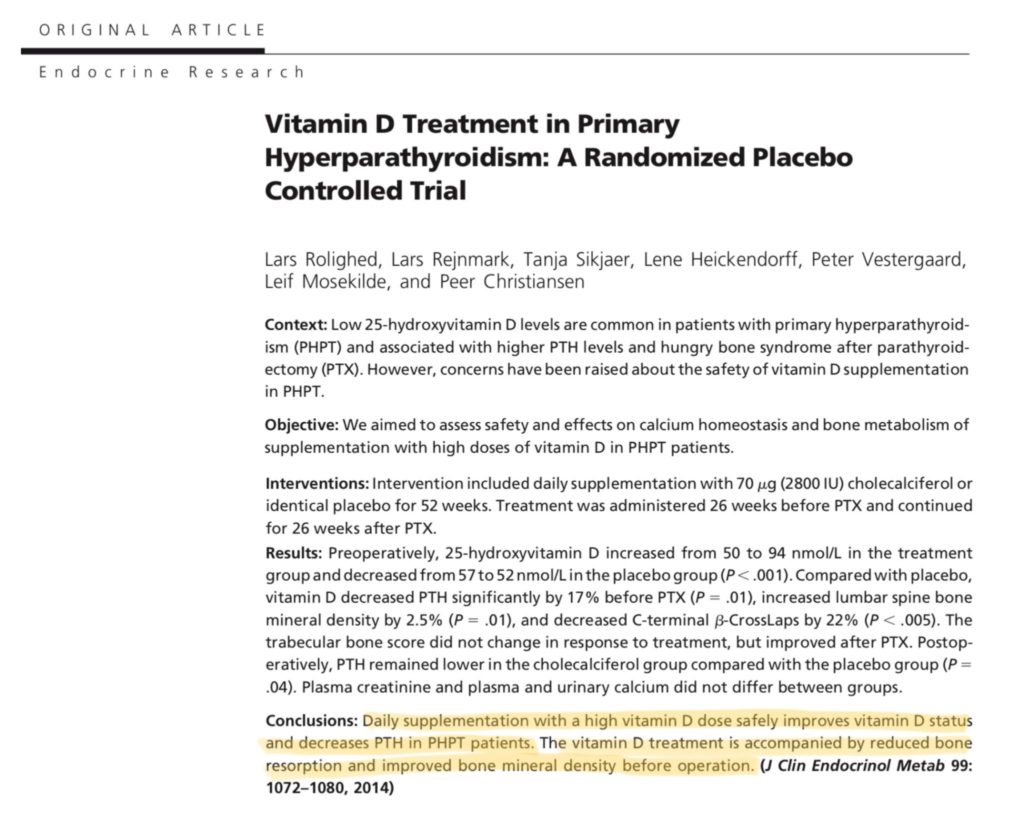
Some patients can increase their vitamin D levels by taking supplements either by using daily or weekly doses. And some will find that taking vitamin D supplements makes them feel worse; probably because the high PTH turns the supplements into high concentrations of 1, 25 dihydroxy vitamin D which is the active form, causing symptoms of vitamin D toxicity. When taking vitamin D makes you feel worse, you should immediately stop. In either scenario, parathyroidectomy will not only correct the calcium/PTH imbalance (PHPT) but also the vitamin D deficiency.
Hyperparathyroidism & Vitamin D FAQ
Q: Is it safe to take vitamin D supplements when a person has PHPT?
A: Yes as long as the vitamin D levels are being monitored. If while you are taking vitamin D, you feel worse, or have new uncomfortable symptoms then you should stop immediately and check your blood levels.
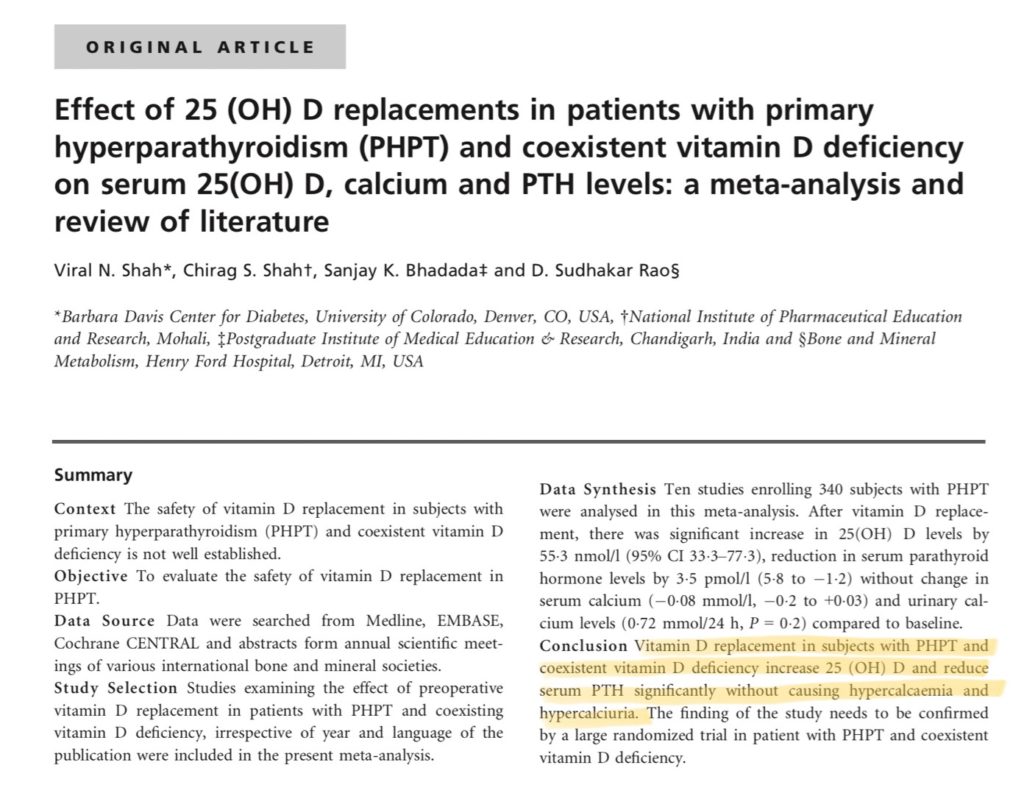
Q: Does Vitamin D intake have an affect on the bones in the setting of PHPT?
A: Yes, taking vitamin D when deficient can help minimize bone loss.
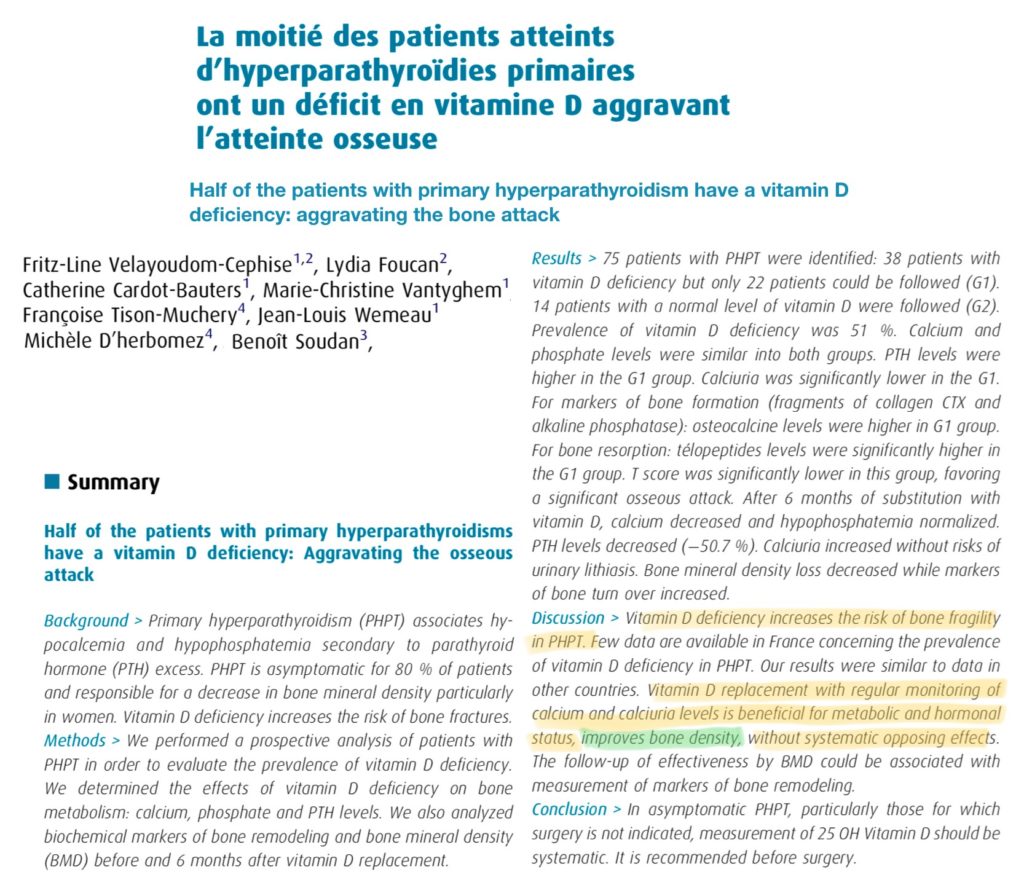
Q: What do I do if I feel bad when I take vitamin D supplements?
A: Immediately stop taking the supplement and contact your doctor. It is important to do blood tests at the time to check calcium, PTH, 25 OH Vitamin D and 1,25 OH Vitamin D to see if you are having vitamin D toxicity and what the impact is on your parathyroid function.
Q: Is it safe to take calcium replacement when you have PHPT?
A: The answer is unclear. No one has been daring enough to do research on people who have PHPT and give them additional calcium supplements.
For More Answers, Watch Dr. Larian’s Hyperparathyroidism FAQ on Facebook Live
Schedule a Parathyroid Disease Treatment Consultation with Dr. Larian Today
Dr. Babak Larian of the CENTER for Advanced Parathyroid Surgery is an expert head and neck surgeon with many years of parathyroid surgery experience. He conducts extensive testing to determine if an individual is dealing with hyperparathyroidism, vitamin D deficiency, or both. Dr. Larian also works closely with patients to help them address their symptoms associated with hyperparathyroidism and low vitamin D levels. To schedule a treatment consultation with Dr. Larian, please contact us today at 310-461-0300.









